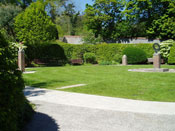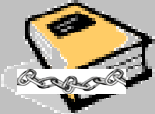
Return to Co. Down list

Go to Prehistoric Alignments & Dials

Go to Ancient Monastic Dials

Go to Medieval Dials

Go to Modern (1600+) Dials

Go to Sundial Info.and Books

Return to Co. Down list |
 Go to Prehistoric Alignments & Dials |
 Go to Ancient Monastic Dials |
 Go to Medieval Dials |
 Go to Modern (1600+) Dials |

Go to Sundial Info.and Books |
 Down Sundial |
|
Seven horizontal slate dials, four dated 1794, 1813, 1855, 1908 and three
undated, in the archives (restricted access - not on display) of the
Ulster Folk &Transport Museum at Cultra on the A2 5Kms west of Bangor. This open air
museum has a typical Ulster town of 100 years ago, farms, cottages, livestock,
award winning railway collection and a TITANIC exhibition. Copyright photos are available, contact me for details. Museum Lat 54°39' North Long 5° 47' West Irish Grid J 343060 380250 |
 |
The 1794 Dial - A worn octagonal slate dial, 305mm across flats. Inscribed "Wm Adair Eng." "LAT 54:54" and dated "1794". Rusted, corroded iron gnomon. Reads hours 4 to 8 in Roman numerals, four a.m. as IIII, four p.m. as IV, 30 and 15 mins. There is an outer minute ring but this is badly eroded |
 |
The 1813 Dial - An octagonal slate dial 330mm across the flats but badly chipped along the sides. Gnomon missing. Reads hours 4 to 8 in Roman numerals, 30 and 15 mins. Incomplete decoration includes what could be masonic symbols. Inscribed in a circle on the gnomon side of the hour ring, starting at IV and ending at VIII "THIS DIAL CUT FOR 54D 15M NORTH LATITUDE BY JOHN JENNINGS IN THE 21st YEAR OF HIS AGE &c. &c" and "A D N 1813". |
 |
The 1855 Dial - A square slate multi-dial, two in the centre and one each corner, all gnomons missing, good condition but cracked in NW corner. The central dials are surrounded by a laurel wreathe with extensions to the sides and four corners, the cardinal points are marked "N" "S" etc. at the edge of the plate. Made "BY.J.C 1855." and the name "JOSEPH MAXWELL" prominent inside a double line box. There is an eight point windrose at the base of all five gnomons. The smaller of the two central dials is delineated for and inscribed "Van Diemens Land Time" "Lat 42.S. Long 150 E" "Longest Day 15 Houers" Reads hours 2 to 6,in arabic numerals, with marks for 30 and 15 mins. Spaced between hour lines, starting at 3/4 is "AFTERNOON". The main dial is for "Latd 54.16 N" Split noon line to compensate for gnomon thickness, reads 3:30 to 8:30 with hours 4 to 8 in Arabic numerals, marks for 30,15 and 5 mins. The four subsidiary dials, one at each corner of the plate are for different geographical locations:- NW corner dial is inscribed "lat 51.31 N" "Long 0" "London time" "Longest Day 14½ houers" Reads hours 5 to 8 with arabic numerals, shows 30 and 15 mins. There is an extended line on the 11:30 position marked "11:00" and "N." NE corner dial is inscribed "lat 60 N" "Long 32 E" "St. Peterburgh time" "Longest Day 18 houers" Reads hours 7 to 10 with arabic numerals, shows 30 and 15 mins. Spaced between hour lines, starting at 12/1 is "AFTERNOON". SE corner dial is inscribed "Jerusalem time""lat 32 N Long 40 E" "Longest Day 14 houers" Reads hours 7 to 11 with arabic numerals, shows 30 and 15 mins. Spaced between hour lines, starting at 12/1 is "AFTERNOON". SW corner dial is inscribed "lat 41 N Long 70" "New York time" "Longest Day 15 houers" Reads hours 12 to 5 with arabic numerals, shows 30 and 15 mins. Spaced between hour lines, starting at 4/5 is "FORENOON". |
 |
The 1908 Dial - 450mm square slate dial with solid brass gnomon and four levelling feet projecting through the plate. Good condition but chipped along the edges. Inscription includes "1908" "BLACK Hd LIGHT H." "Lat N ??" " Long W ??". "?? Dublin ??" Reads 3:30 to 8:30 with hours 4 to 8 in Roman numerals, four a.m. as IIII, marks for 30,15 and 5 mins. There is an Equation of time table on the gnomon sides of the hour ring in the form - "Days and Month" and "Minutes" "Clock Faster" "Clock Slower". |
 |
An undated dial - An octagonal slate dial plate in excellent condition, 235mm across flats. Inscribed with"James Walsh: Sculpsit". A piece of iron, possibly the gnomon, is separated from but packed with the dial. There is an eight point compass rose marked "N", "NE", "E" etc. at the base of the gnomon. Working out from the gnomon after the compass rose comes the Equation of Time rings in the form of concentric circles - "Fast" and "Slow", then the months in full "January", "February" etc. then the date of each month in arabic numerals "8", "15", "22" etc. then the E.o.T. minutes marked in arabic numerals. Next comes an hour, 30min and 15 min ring with the half hour marked with fleur-de-lys. The hours 4 to 8 are marked with Roman numerals, four as IIII, then there is another time ring - hours, 30mins, 15mins and 5mins. The half hours again marked with fleur-de-lys. There is a split noon to compensate for the gnomon thickness. There are three fixing holes equally spaced along the perimeter from noon. |
 |
An undated dial - An unfinished octagonal slate dial 300mm across flats, with a perforated brass gnomon, now detached. There is an eight point compass rose and a series of ten concentric circles. The split noon lines are inscribed as are some of the hour lines and that is all. |
 |
An undated dial - An unequal octagonal slate dial now damaged around the edge and in a roughly oval shape 400mm by 320mm. The dial is insribed in an ellipse hence the reason for the unequal octagon. The iron gnomon is a simple rod with one vertical support. The hours 6 to 6 are marked with Arabic numerals. Four concentric time rings radiate from the gnomon - first an hour ring, then hour and half hours, then hours, half hours,quarter hours with a dot between the quarters for 7½ mins |